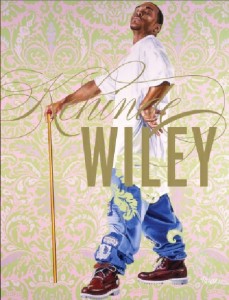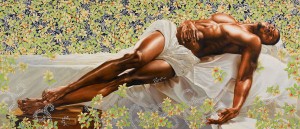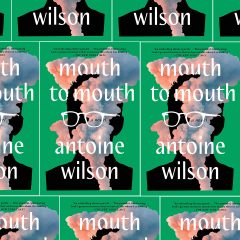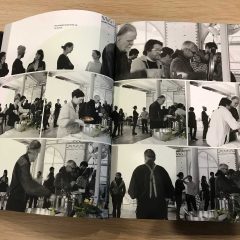by Mireille Guy
Kehinde Wiley’s portraits of men of color, portrayed as kings, knights, or saints out of Western history paintings, juxtapose issues of race and gender with ideas of power, and ask important questions about the role of young black males today.
Kehinde Wiley, the new 248-page book by Rizzoli, is a great introduction to the celebrated portrait painter. The book is filled with full-page images, an interview with Wiley, and various essays on his work and its social implications. The hard cover edition is a massive nine and a half by twelve and a half inches with gold-edged pages like a bible. It’s a perfect coffee table book, with great content. Contributors include the Director and Chief Curator of The Studio Museum in Harlem, Thelma Golden, UVA art historian Robert Hobbs, art scholar Sarah Lewis, author Brian Keith Jackson, and an interview by artist and Index magazine founder Peter Halley.
Wiley photographs his models — men he sees on the street, who agree to work with him. Dressed in their street clothes these men are asked to pick out poses to emulate from portrait books of old master paintings. In Sarah Lewis’s essay, Wiley explains his ease in finding models: “Painting in the twenty-first century is so much about responding to the post-MTV generation. The reproduced self is something that one imagines in relationship to reality television, this expectation of fame…When I meet people on the streets and propose to them to have them celebrated in large paintings, there is this feeling of, “Oh, of course now is my time.”
The African American artist, who lives in New York, has degrees from the San Francisco Art Institute (BFA) and Yale University’s School of Art (MFA). He began showing his work in 2001 and is considered a contemporary descendent of portrait masters such as Titian, Reynolds, and Gainsborough. This is evident in his strong technical skill, which is a realistic style that can be compared to that of Old Master painters.
What sets Wiley apart is his ability to intertwine images of majestic and noble western ideals with ideas that address the status of young urban black men in society.
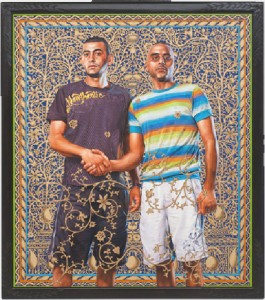
The artist’s background sheds light on how he arrived at this extraordinary combination of material. Having grown up in Los Angeles in the 1980’s he was exposed to racial violence and hip-hop, he says, and is very much a product of that environment. As a result his portraits are on one level a critique of the absence of black subjects in western art history, yet they also celebrate the grandeur of portraiture.
This book encompasses his early works as well as his most recent, with portrait subjects including African-Americans, natives of the Middle East, and Africa. Wiley creates such sharp contrasts in his paintings, he allows his ideas and questions to be brought up in a very accessible manner.
Currently fourteen of Wiley’s portraits are on view at The Jewish Museum in New York (until July 29) and they are definitely worth seeing (free on Saturdays). The work in this exhibit, The World Stage: Israel, is different from his previous works and different from what’s in this book, as it focuses on the social and political anxiety of Arabs and Ethiopian Jews in Israel. It is spectacular seeing his portraits in person, where the massiveness of the paintings can really be appreciated.
Kehinde Wiley, Hardcover, $65, ISBN: 978-0-8478-3549-2. www.rizzoliusa.com
–artblog intern Mireille Guy is a student at Swarthmore College.


